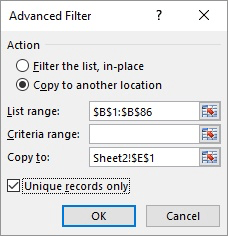Please Note: This article is written for users of the following Microsoft Excel versions: 2007, 2010, 2013, 2016, 2019, 2021, 2024, and Excel in Microsoft 365. If you are using an earlier version (Excel 2003 or earlier), this tip may not work for you. For a version of this tip written specifically for earlier versions of Excel, click here: Filtering Columns for Unique Values.
Written by Allen Wyatt (last updated January 25, 2025)
This tip applies to Excel 2007, 2010, 2013, 2016, 2019, 2021, 2024, and Excel in Microsoft 365
It is not unusual to acquire or develop data tables that have duplicate values in a column. If you want to see only the unique values, without the duplicates, you want to filter your data table. Excel makes this rather easy for most scenarios. For instance, let's say you have a data table in which you have part numbers in column A. If you want to filter the list so you see only unique part numbers, you can follow these steps:

Figure 1. The Advanced Filter dialog box.
If you are using Excel 2021, 2024, or Excel in Microsoft 365, you can also use the UNIQUE function to grab a unique set of values from the part numbers list. You can find out more about the UNIQUE function by checking out this ExcelTip:
https://tips.net/T12835
One of the great things about using the UNIQUE function is that it is dynamic, meaning that if you update your original list of part numbers, then what is returned by UNIQUE is updated, as well. This doesn't happen if you use the Advanced Filter dialog box to copy the results of a filter to a different location.
ExcelTips is your source for cost-effective Microsoft Excel training. This tip (8732) applies to Microsoft Excel 2007, 2010, 2013, 2016, 2019, 2021, 2024, and Excel in Microsoft 365. You can find a version of this tip for the older menu interface of Excel here: Filtering Columns for Unique Values.

Solve Real Business Problems Master business modeling and analysis techniques with Excel and transform data into bottom-line results. This hands-on, scenario-focused guide shows you how to use the latest Excel tools to integrate data from multiple tables. Check out Microsoft Excel Data Analysis and Business Modeling today!
Many people know how to use AutoFilter, but there are times when you need some more filtering muscle. Here's how you can ...
Discover MoreIf you have a bunch of data in an Excel worksheet, you may need to work with just a subset of that data. One way to do ...
Discover MoreFREE SERVICE: Get tips like this every week in ExcelTips, a free productivity newsletter. Enter your address and click "Subscribe."
There are currently no comments for this tip. (Be the first to leave your comment—just use the simple form above!)
Got a version of Excel that uses the ribbon interface (Excel 2007 or later)? This site is for you! If you use an earlier version of Excel, visit our ExcelTips site focusing on the menu interface.
FREE SERVICE: Get tips like this every week in ExcelTips, a free productivity newsletter. Enter your address and click "Subscribe."
Copyright © 2025 Sharon Parq Associates, Inc.
Comments